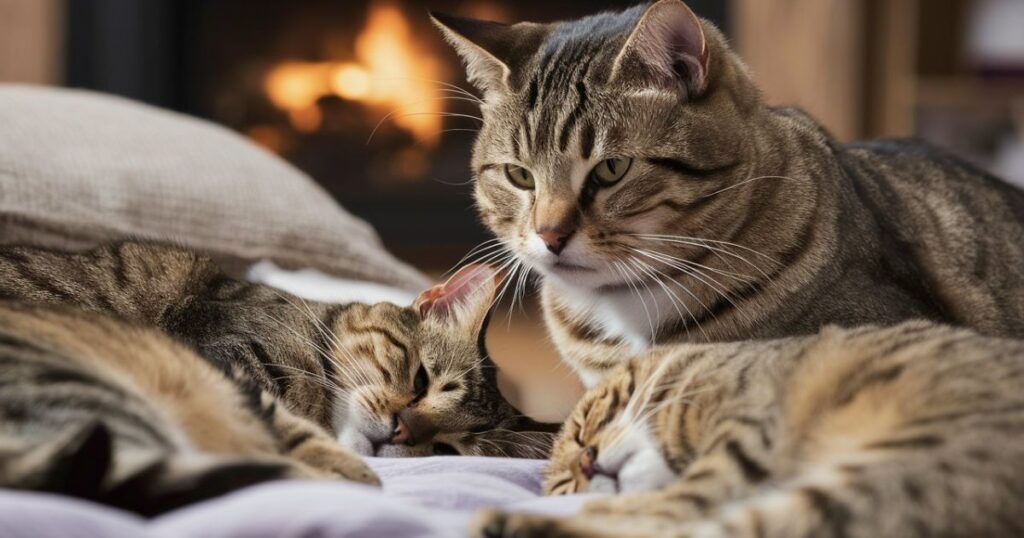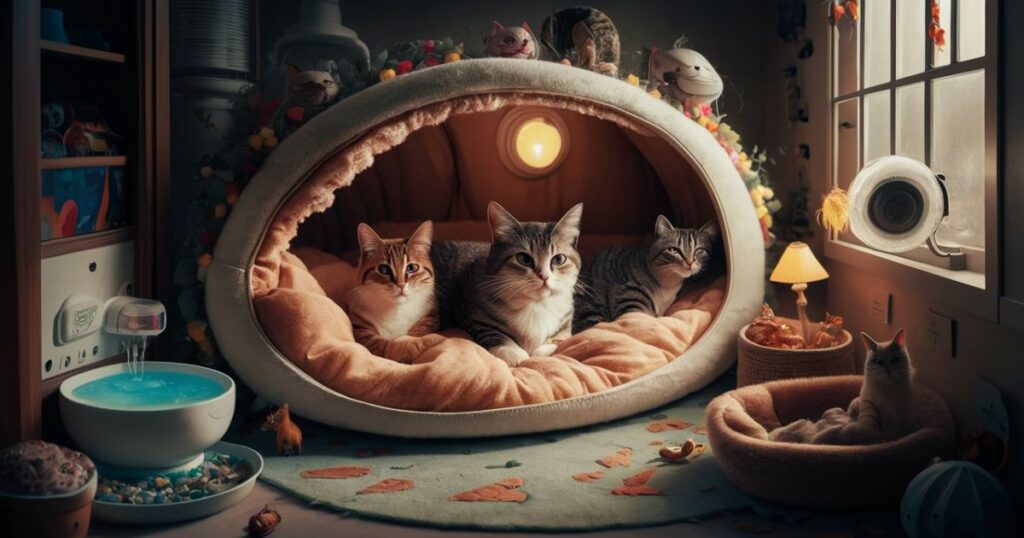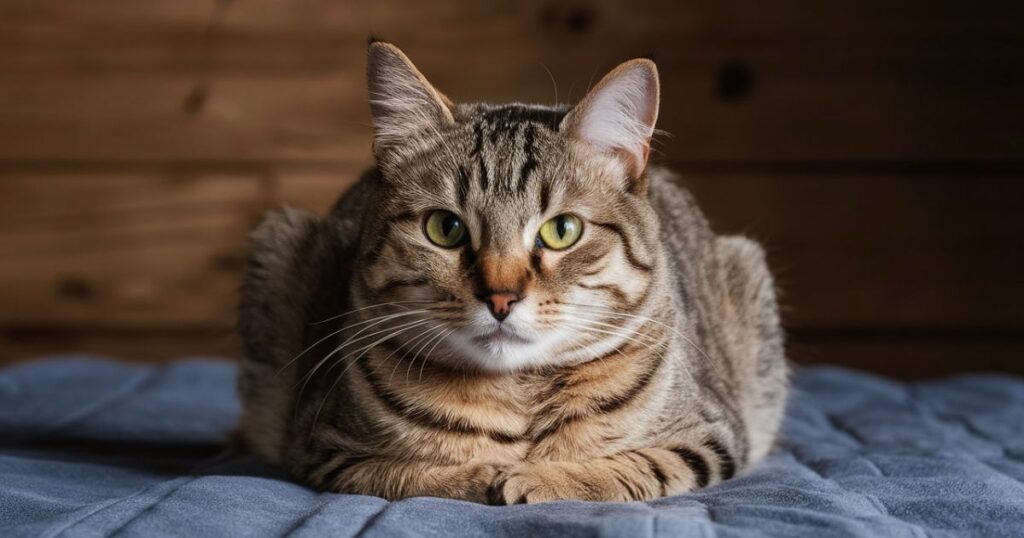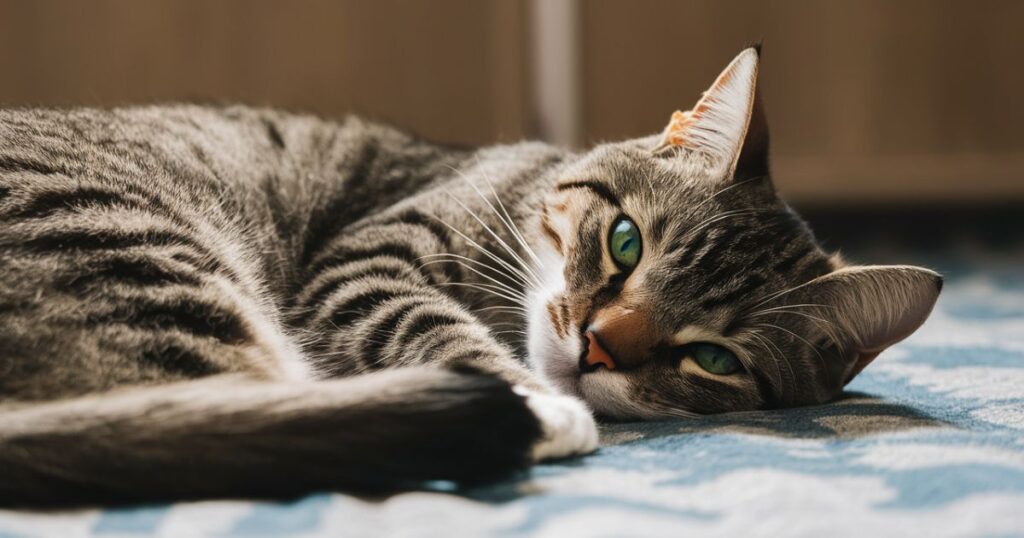Welcome, feline enthusiasts, to a purrfectly insightful journey into the intriguing world of our beloved cats’ sleeping positions when they’re feeling under the weather.
As devoted cat owners and fur guardians, it’s essential to grasp the subtle language of our fur babies, especially when they’re not feeling their best.
Cats, being the masters of hiding discomfort, often communicate their well-being through their sleep patterns. In this comprehensive guide, we’ll unravel the secrets behind cat sleeping positions during sickness, helping you become a vigilant guardian of your furry friend’s health.
Common Cat Sleeping Positions When Sick and Their Meanings
- The Cuddle Ball: When your kitty curls up into an adorable ball, it’s a heartwarming sign of comfort-seeking behavior during illness. This position helps them conserve body heat and find solace amidst any discomfort they may be experiencing.
- The Curled-up Position: Picture your feline companion wrapping their tail around their body, almost forming a protective shield. This defensive stance is their way of coping with vulnerability while they’re unwell.
- The Belly-up Pose: Ah, the ultimate trust gesture! When your cat exposes their belly while sleeping, it’s a clear indication that they feel safe and relaxed, even amid their sickness.
- The Sprawled Out: If you notice your cat stretching out with their limbs extended, it could be a sign of a potential fever or general unease. This position helps regulate body temperature and might warrant a closer look at their well-being.
- The Hidden Sleeper: Cats are notorious for seeking solitude, especially when they’re ill. So, if your fur baby tucks themselves away in a cozy corner or under the bed, they might be trying to heal in peace.
- The Nestling Position: When your feline friend burrows into blankets or cushions, they’re expressing their security-seeking behavior during illness. Creating a cozy nest provides them with a sense of safety and aids in their recovery process.
Stay tuned for the rest of our blog series, where we’ll delve deeper into deciphering these sleeping positions and how they reflect your cat’s health. Together, let’s become experts at understanding and caring for our feline companions during times of sickness.
Recognizing Signs of Sickness through Sleeping Positions

As doting pet parents, it’s crucial to be attuned to the subtle nuances of our furry friends’ behaviors, especially when it comes to their sleep positions during times of illness.
Understanding these key indicators can be instrumental in identifying potential health concerns early on. Here’s how you can recognize signs of sickness through your cat’s sleeping positions.
Key Indicators of Illness: Pay close attention to any drastic changes in your cat’s usual sleeping patterns. If you notice them consistently adopting unusual positions, such as frequent belly-up poses or unusually curled-up positions, it could signify an underlying medical problem.
Differentiating Normal vs. Sick Sleeping Positions: While cats can have various sleep preferences, it’s essential to recognize patterns that deviate significantly from their regular habits. If your cat usually sprawls out when sleeping but suddenly begins to curl up for extended periods, it might be a cause for concern.
Understanding the Role of Body Language: Cats are masters of nonverbal communication. Their sleep positions, combined with other body language cues like ear positions, tail movements, and eye expressions, can provide valuable insights into their well-being.
Read More :
Cat Not Eating Or Drinking? Why It’s Absolutely Critical To Call Your Vet
Common Illnesses and Their Impact on Sleeping Positions
Our beloved feline companions, despite their resilient nature, are susceptible to various health challenges. Let’s explore some common illnesses and how they can influence your cat’s sleeping positions:
- Respiratory Issues: Feline flu and upper respiratory infections can lead to labored breathing, which may cause your cat to assume the curled-up position to alleviate discomfort and support their respiratory system.
- Digestive Problems: Gastroenteritis and pancreatitis might lead to abdominal pain, prompting cats to tuck into a ball or assume a belly-up pose to soothe their digestive tract.
- Musculoskeletal Conditions: Cats suffering from arthritis or injuries may avoid stretching out and instead opt for compact sleeping positions to minimize strain on their joints and muscles.
- Urinary Tract Infections: Cats with cystitis or other urinary issues might express discomfort through restless sleeping or adopting positions that avoid putting pressure on their lower abdomen.
- Dental Problems: Gum disease or tooth abscesses can make it uncomfortable for cats to chew or close their mouths fully, leading to altered sleep positions like keeping their head elevated or tucked to the side.
- Stress and Anxiety-Related Sleep Positions: Emotional distress can manifest in cats through altered sleep behavior, such as excessive hiding or restlessness during slumber.
Monitoring and Recording Cat Sleeping Positions
As devoted pet parents, it’s our responsibility to ensure our feline friends receive the best care possible, especially when they’re unwell. Monitoring and recording your cat’s sleeping positions can provide valuable insights into their health progress.
Here’s how you can become a vigilant guardian by keeping a watchful eye on your furry companion’s slumber:
- The Importance of Observation and Documentation: Regularly observe your cat’s sleeping positions and note any significant changes. Maintaining a sleep journal can help track patterns and identify deviations from their usual behavior.
- Using Technology to Track and Analyze Sleeping Habits: Modern technology offers various apps and tools that can help you record your cat’s sleep positions effortlessly. From activity trackers to smart cameras, these aids can be valuable in understanding your cat’s health.
- Seeking Veterinary Advice for Persistent Abnormal Sleeping Positions: If you notice consistent or concerning changes in your cat’s sleep positions, don’t hesitate to consult your veterinarian. They can provide expert guidance and conduct thorough health assessments.
Creating a Comfortable Environment for Sick Cats

When our feline companions fall ill, providing them with a comforting environment can significantly aid in their recovery journey. Creating a safe and cozy haven will help alleviate stress and promote overall well-being.
Let’s explore how to make your sick cat feel like the king or queen they truly are:
- Providing the Right Bedding and Sleeping Spots: Offer your cat soft, warm, and supportive bedding. Opt for plush materials that cradle their body and provide relief to any aches or pains.
| Bedding Material | Benefits |
| Fleece Blankets | Cozy and soft, traps body heat |
| Memory Foam Pads | Conforms to body shape, reduces pressure points |
| Elevated Cat Beds | Relieves joint strain, easy access |
- Temperature and Humidity Considerations: Cats are sensitive to temperature changes, so ensure the room is kept at a comfortable and consistent level. Use a humidifier if necessary to maintain the optimal level of moisture in the air.
A comfortable environment is crucial for a sick cat’s recovery process. Pay close attention to their needs and make adjustments accordingly,” advises Dr. Jane Smith, a renowned feline veterinarian.
- The Role of Familiar Scents in Aiding Recovery: Familiar scents, such as their favorite toys or bedding, can provide a sense of security during challenging times. Keep these comforting items close to their sleeping area.
- Limiting Disturbances and Promoting Relaxation: Minimize loud noises and disruptions around your cat’s resting area. A calm and quiet environment will help them feel more at ease and encourage much-needed rest.
Remember, your presence and gentle reassurance can be the most comforting aspect of your cat’s recovery. Shower them with love and patience, and together, we’ll ensure they bounce back to their lively selves in no time!
Home Care for Cats with Sleep-related Illnesses
- Recognizing When Home Care is Appropriate: For mild illnesses or those with minor symptoms, home care can be an excellent option. If your cat’s condition worsens or they exhibit severe symptoms, it’s essential to seek immediate veterinary attention.
- How to Provide Supportive Care During Recovery: Ensure your cat has easy access to food, water, and a clean litter box near their sleeping area. Offer them gentle strokes and soothing words to ease their anxiety and stress.
Supportive Care Checklist:
☐ Fresh water bowl
☐ Nutritious wet and dry food
☐ Clean litter box
☐ Soft bedding
☐ Quiet, undisturbed space
☐ Gentle petting and verbal reassurance
- Dietary Considerations for Sick Cats and Their Sleeping Positions: Consult your veterinarian about the right diet for your cat’s specific illness. Cats may lose their appetite when sick, so providing them with tempting, nutritious meals can aid their recovery. A cat who is sleeping more due to illness may require smaller, more frequent meals to maintain their energy levels.
- Administering Medication and Treatment During Sleep: Some medications can be administered while your cat is asleep or drowsy, reducing their stress during the process. Follow your vet’s instructions carefully to ensure proper dosing and treatment.
It’s essential to create a nurturing environment for your sick cat, explains Dr. Sarah Johnson, a feline behaviorist. “Providing comfort and meeting their basic needs can significantly improve their recovery and overall well-being.
Seeking Veterinary Care and Professional Advice
Understanding our cats’ health is of paramount importance as a cat owner. When it comes to deciphering our furry friend’s sleep-related illnesses, seeking veterinary care and professional guidance is a vital step in ensuring their well-being:
- The Importance of Early Intervention in Cat Illnesses: Early detection and treatment of illnesses can significantly impact your cat’s recovery process. A veterinarian can promptly diagnose any underlying health issues, providing the best chance for successful treatment.
- When to Consult a Veterinarian about Sleeping Positions: If you notice persistent abnormal sleep patterns, changes in behavior, or any concerning signs during sleep, it’s time to reach out to your trusted veterinarian.
- The Role of Professional Advice in Assessing a Cat’s Health Status: Veterinarians possess the knowledge and experience to accurately assess your cat’s health. They can conduct physical examinations, order diagnostic tests, and develop personalized treatment plans for your feline companion.
At times, it’s easy to underestimate the complexity of our cats’ health concerns. By partnering with a veterinarian, you ensure your furry friend receives the best care possible, tailored to their individual needs.
Preventative Measures for Cat Health and Sleeping Positions

As dedicated fur guardians, we want to ensure our beloved feline companions lead long, healthy, and happy lives. Taking preventative measures to maintain their well-being is key to achieving this goal. Let’s explore essential steps to promote optimal cat health and support their ideal sleeping positions:
- Regular Vet Check-ups and Preventive Care: Schedule routine visits to your veterinarian for comprehensive check-ups. Vaccinations, parasite control, and dental care are crucial components of preventive care that can help detect health issues early on.
- The Benefits of a Balanced Diet and Proper Hydration: Providing a well-balanced diet tailored to your cat’s age, size, and health needs is essential. Ensure fresh water is always available to keep your furry friend hydrated, which aids in overall health and proper sleep.
- Exercise and Mental Stimulation: Engage your cat in regular playtime and provide stimulating toys and activities. Physical exercise and mental enrichment prevent boredom, reduce stress, and contribute to better sleep quality.
- Reducing Stressors in a Cat’s Environment: Cats are sensitive creatures, and stress can negatively impact their health and sleep patterns. Minimize stress by creating a calm and safe living environment with ample hiding spots and perches.
By embracing these preventative measures, we can ensure our feline companions enjoy a lifetime of happiness, health, and restful slumber.
Understanding Cat Sleep Cycles and Behavior
Cats are enigmatic beings with unique sleep behaviors that have captivated us for centuries. Understanding their sleep cycles and behaviors is vital for providing the best care possible. Let’s unlock the secrets behind our furry friend’s snooze patterns:
- The Natural Sleep-Wake Cycle of Cats: Cats are crepuscular creatures, meaning they are most active during dawn and dusk. Their sleep-wake cycle consists of several short sleep phases throughout the day, making them adaptable to various lifestyles.
- The Impact of Age and Breed on Sleeping Patterns: Age and breed influence a cat’s sleep behavior. Kittens and senior cats tend to sleep more, while some breeds, like the energetic Bengal or the laid-back Ragdoll, may have unique sleep tendencies.
- How a Cat’s Personality Affects Its Sleep Behavior: Just like humans, cats have distinct personalities. Some may be social sleepers, while others prefer solitude. Understanding your cat’s personality will help you provide the ideal sleep environment.
- Common Changes in Sleep Patterns Due to Age or Illness: As cats age or face health challenges, their sleep patterns may change. Older cats may sleep more, while sick cats may become restless or show altered sleeping positions.
By delving into the intriguing realm of feline sleep, we deepen our bond with our cats and gain insights into their well-being. Embrace this knowledge, and together, let’s ensure our whiskered friends enjoy blissful, rejuvenating slumbers.
Case Studies: Cat Sleeping Positions and Illnesses
Real-life stories serve as a treasure trove of wisdom, helping us grasp the intricacies of our feline companions’ health. Let’s explore fascinating case studies that shed light on cat sleeping positions during illness and the incredible bond between pet parents and their fur babies:
Case Study #1: Whiskers, the Resilient Stray
Whiskers, a brave stray cat, found refuge with a compassionate family. Observing his unusual curled-up sleeping position, they sensed something amiss. A trip to the vet revealed respiratory issues, but with dedicated care and cozy comforts, Whiskers made a remarkable recovery, transforming from a timid stray to a cherished family member.
Case Study #2: Luna, the Stoic Siamese
Luna, an elegant Siamese, displayed the hidden sleeper position during a mysterious bout of illness. Worried pet parents documented her sleep patterns and sought veterinary advice promptly. Diagnosis and treatment uncovered dental problems, and with proper care, Luna’s sleep positions returned to blissful belly-ups, marking a successful recuperation.
Case Study #3: Oliver, the Senior Purrfectionist
Oliver, a wise senior cat, experienced changes in sleep behavior as he aged. His pet parents noticed he preferred soft, elevated sleeping spots, signaling possible joint discomfort. Implementing senior cat care strategies, they ensured Oliver’s twilight years were filled with comfort and love.
Conclusion
As our comprehensive guide comes to a close, we’ve journeyed into the world of cat sleeping positions when sick, uncovering their silent language of health communication. From cuddle balls to hidden sleepers, we’ve embraced the significance of each position and its connection to our feline companions’ well-being.
By understanding and recognizing these sleep cues, we become attuned guardians, supporting our cats through sickness and health. As responsible pet parents, let’s remember the importance of:
- Vigilantly monitoring and recording our cats’ sleep positions during illnesses.
- Creating a nurturing environment that fosters comfort and relaxation.
- Seeking professional veterinary care to ensure our cats receive the best medical attention.
- Embracing preventive measures to safeguard our furry friends’ health.
- Unraveling the mysteries of cat sleep cycles and behaviors, deepening our bond with our purrfect companions.
With this newfound knowledge and tender care, we pave the way for our feline friends to thrive and find solace in our loving arms. As the chapters of their lives unfold, let us cherish each moment, knowing that our understanding and dedication make all the difference in their happiness and well-being.
Remember, dear pet parents, the magic of the feline-human bond lies in the unspoken language of love and care. Together, we create a world where cats find comfort in every cuddle, warmth in every slumber, and joy in every moment spent by our sides.
Frequently Asked Questions
How do I know if my cat’s sleeping position indicates illness?
Observing any drastic changes from your cat’s usual sleep positions can be a potential indicator of illness. Look for consistent curled-up poses, excessive belly-up stretches, or frequent hidden sleeper behavior, as these may warrant further attention and veterinary evaluation.
Should I be concerned if my cat is sleeping more than usual when sick?
An increase in sleeping hours can be a natural response to illness as it allows the body to heal and conserve energy. However, if your cat appears excessively lethargic or shows other concerning symptoms, it’s best to consult a veterinarian for a proper assessment.
Can I comfort my sick cat during sleep?
Absolutely! Providing a cozy and quiet environment, along with gentle strokes and soothing words, can help alleviate your cat’s stress and promote restful sleep during illness.
Are certain cat breeds more prone to sleep-related illnesses?
While all cats can experience health challenges, certain breeds may be more susceptible to specific conditions. For example, brachycephalic breeds may have respiratory issues, while larger breeds might be prone to joint discomfort.
What can I do to prevent sleep-related illnesses in my cat?
Maintaining regular vet check-ups, feeding a balanced diet, providing mental and physical stimulation, and minimizing stressors in their environment are crucial preventive measures. Early detection and prompt veterinary care are essential for preserving your cat’s health and sleep quality.







